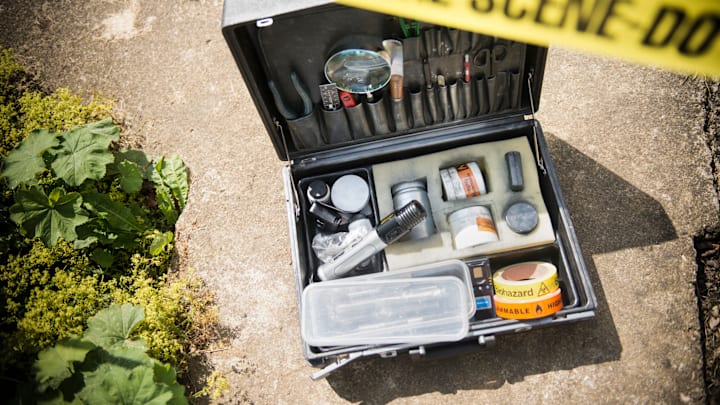In the United States, the term murder bag has been used to describe a collection of tools a killer might use to stalk, subdue, and attack a victim. In the UK, though, the term has a very different connotation: It refers to the iconic toolkits used by 20th-century Scotland Yard investigators to process the scenes of violent crimes.
The murder bag provided detectives with the equipment they needed to find, document, and collect evidence, including a magnifying glass, measuring devices, swabs, sample bags, scissors, and tweezers. But the reason anyone thought to assemble the bags in the first place was to equip them with something a little less glamorous: rubber gloves. And if you think gloves aren’t an indispensable part of an investigator’s tool bag, you obviously weren’t on scene to deal with the aftermath of the 1924 murder of Emily Kaye—the gruesome crime that spurred the creation of the murder bag and changed the course of forensic science.
A Ghastly Discovery
In May 1924, Patrick Mahon was arrested at London’s Waterloo train station when he tried to retrieve a bag he’d left there earlier. Unbeknownst to Mahon, the bag had been found and examined by a private detective hired by Mahon’s wife, who’d discovered a luggage claim ticket while searching for some clue as to her husband’s whereabouts. The detective had alerted Scotland Yard about what he found in the bag: a large knife and bloodied clothing. Police were eager to discuss those items with Mahon.
Once he was in custody, it didn’t take long for Mahon to direct authorities to a bungalow he’d shared with his mistress, Emily Kaye. Mahon claimed Kaye had thrown an axe at him during a heated argument, then died after falling and hitting her head on a coal bucket. According to Mahon, he had panicked and spent the next several days attempting to obliterate the body of the woman he definitely didn’t murder.
“Are There No Rubber Gloves?”
Police wasted no time in summoning the recently knighted Sir Bernard Spilsbury to the scene of the crime. Spilsbury was a pathologist whose testimony had been crucial in the 1910 trial of Hawley Crippen, an American doctor who was convicted of murdering and dismembering his wife. Spilsbury’s role in the case, and his work on subsequent, high-profile murder investigations, had made him a celebrity in the waning years of what George Orwell called England’s “great period in murder”: a 75-year stretch when the country seemed to bounce from one sensational murder trial to the next.
Even an investigator as seasoned as Spilsbury must have been horrified by the scene that awaited him. According to Colin Evans’s 2006 book The Father of Forensics, Mahon had dismembered Kaye’s body and attempted to dispose of the pieces by boiling, burning, or squirreling them away throughout the bungalow. In the living room area, police found fragments of bone in the fireplace and a piece of flesh in a large pot on the hearth. In a bedroom, they found more of Kaye’s remains stuffed in a trunk, a hatbox, and a cookie tin.

Spilsbury set up an impromptu laboratory in the bungalow’s courtyard to process evidence, requesting that Kaye’s remains be brought out to the makeshift facility. Apparently without giving it a second thought, the officers proceeded to fill buckets with the decomposing body parts—using their bare hands. “Are there no gloves?” an appalled Spilsbury asked Chief Inspector Percy Savage, who told him his men never wore gloves or any other type of personal protective equipment.
The pathologist was initially mortified about the potential for infection, but he later learned that the officers tasked with processing crime scenes were fundamentally underequipped for their work. Forget essential hygiene and sanitation supplies—they didn’t even have tape measures, tweezers, or tools for collecting fingerprints. (The UK had been using fingerprint evidence to investigate and prosecute crimes for more than 20 years by then.)
Spilsbury enlisted the aid of Savage, a police surgeon named Aubrey Scott-Gillett, and Scotland Yard’s Detective Superintendent William Brown to assemble the world’s first known “murder bag.”
In the Bag
The contents of a murder bag might seem like common sense to anyone who’s ever seen an episode of CSI, but they were novel enough to receive widespread press coverage in the 1920s. A short item in a 1927 edition of The New York Times announced that Scotland Yard had acquired five new murder bags and catalogued their contents, which included measuring devices, magnifying glasses, a flashlight, test tubes, tweezers, handcuffs, and “complete finger-printing apparatus,” along with a few items that must have made Spilsbury’s heart sing. Besides his beloved rubber gloves (two pairs!), investigators would also have a rubber apron, disinfectant in both topical and tablet form, and a bar of soap (though this was mainly used to take impressions of small objects found at a crime scene).
The murder bag continued to evolve over the years, with Scotland Yard increasing its inventory of bags and expanding their contents as needed. There were six murder bags on hand by 1930, with each now including zinc molds for preserving footprints. By 1955, the inventory stood at eight bags. In 1957, a widely published wire story reported that Londoners were so busy killing each other that Scotland Yard was running out of murder bags. That same year, the kits became even further embedded in British culture with the premiere of Murder Bag, a half-hour crime drama that ran until 1959 before morphing into Crime Sheet and, later, No Hiding Place.
Murder bags in their original form have since been relegated to history books and crime museums, but their spirit lives on in the form of modern forensics kits—which, Spilsbury would be glad to know, include gloves, facemasks, and other personal protective equipment.
Read More About True Crime:
